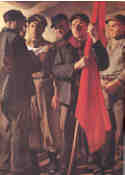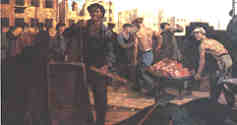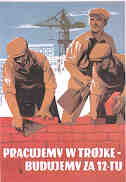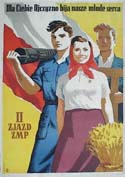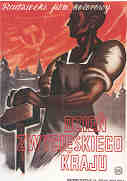
Art from the Socialist Realism Period
Click on image for enlargement
| At the end of the Second World War, Poland was consigned by the allies to the Soviet Union's "sphere of influence." As a consequence, a communist system of government and a largly Soviet system of values was imposed on the country. In the arts, painters were expected to paint in a realistic but monumental style designed to glorify workers and the socialist state. That style had became art dogma in the Soviet Union in the early thirties and was called "socialist realism," or socrealism for short. Following the death of Stalin in 1953 and Nikita Khrushchev's denunciation of Stalin's atrocities in 1957, it was abandoned in Soviet Union and Polish artists no longer were obliged to follow it. Alltogether such superheroic art affecting what purported to be realistic portrayals proved to be a hallmark of the artistic expression of the 20th century's totalitarian regimes. See essay by Reyland for Socrealizm in music, by Franklin in literature. | |
Wojciech Weiss (1875 - 1950)Manifest (The Manifesto]oil on canvas, 1950. This painting by an artist of the older generation is considered to this day as the highest achievements of the social realism period, although it is not the most characteristic of the period. It received the First Prize of the Ministry of Culture. It embodies the seventy five year old artist's optimistic regard for the actuality of the times. In a radio interview, Weiss said of the painting "Ours is a revolutionary time . . . I tried to capture in this painting this moment in history - the arrival of the manifesto, the Revolutionary Manifesto, that the workers are reading. The manifesto is a new interpretation of our existence, a new light which enlightens people." |
|
Helena Krajewska (1910 -Brygada Młodzieżowa na szybko¶ciowcu (Youth Brigade on an Accelerated Construction Site),painting,1950. This socrealistic painting has symbolic meaning. The rebuilding of Warsaw, Poland’s capital, was a unique event, not simply as a construction feat, but also as an idealistic, political, patriotic, organizational and psychological effort. It was event participated in massively and accepted by the majority of the population with authentic enthusiasm. Evident one hand is the photographic realism, yet on the other hand it is totally unlike a photograph since it is monumental in each form and aims at a severe stylization. |
|
Włodzimierz Zakrzewski (1916 -1992)Zjednoczeni budujemy siłę i przyszło¶ć Polski (United we build the strength and future of Poland),poster, 1952 Workers, peasants, soldiers, and women marching towards the vision of new Poland promised by the Party to those who will follow it. In other words, they themselves are the embodiments, or rather the actors of this promise: working people, free of exploitation, united in a common effort undertaken for the common good. |
|
Wiktor Górka (1922 -)Pracujemy w trójkę - budujemy za 12-tu (We work as a trio - do the work of 12),poster, 1953. |
|
Mieczysław TeodorczykDla ciebie ojczyzno bij± nasze młode serca. II Zjazd ZMP (For You Fatherland, our young hearts beat. 2nd Convention of the Alliance of Polish Youth),Poster, 1955 |
|
Stanisław GusykaDzień zwycięskiego kraju (The Day of the Victorious Country),Poster for a Soviet Film, 1948 |
|
|
| |
| Info-Poland a clearinghouse of information about Poland, Polish Universities, Polish Studies, etc. |
